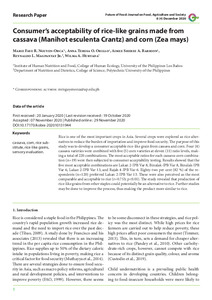Datum
2020-11-29Autor
Nguyen-Orca, Marie Faye RamirezOrillo, Anna Teresa O.Barrion, Aimee Sheree A.Magpantay, Reynaldo LojoHurtada, Wilma A.Metadata
Zur Langanzeige
Aufsatz

Consumer acceptability of rice-like grains made from cassava (Manihot esculenta Crantz) and corn (Zea mays)
Zusammenfassung
Rice is one of the most important crops in Asia. There are several crops that can be utilized as an alternative to rice. This can help reduce the burden of rice importation and improve food security. The purpose of this study was to develop a consumer acceptable rice-like grains from cassava and corn. A total of 220 combinations of rice-like grains from different cultivars of cassava (Binulak, Lakan 1, Lakan 2, Rajah 4) and corn (IPB Var 6, IPB Var 8, IPB Var 11, IPB Var 13) were developed. Most acceptable combinations were then subjected to consumer acceptability testing. Results showed that the five most acceptable combinations are Lakan 2-IPB Var 8, Binulak-IPB Var 8, Binulak-IPB Var 6, Lakan 2-IPB Var 13, and Rajah 4-IPB Var 6. Eighty two percent (82 %) of the respondents preferred Lakan 2-IPB Var 13 from among all the 20 combinations. These were also perceived as the most comparable and acceptable to rice (r=0.753; p<0.01). The study revealed that production of rice-like grains from other staples can potentially be an alternative to rice. Further studies may be done to improve the process thus making the product more similar to rice.
Zitierform
In: Future of Food: Journal on Food, Agriculture & Society Vol. 8 / No. 4 (2020-11-29) EISSN 2197-411XSammlung(en)
Vol 08, No 4 (2020) (Future of Food: Journal on Food, Agriculture & Society // The Future of Food Journal: Journal on Food, Agriculture & Society)Zitieren
@article{doi:10.17170/kobra-202010131944,
author={Nguyen-Orca, Marie Faye Ramirez and Orillo, Anna Teresa O. and Barrion, Aimee Sheree A. and Magpantay, Reynaldo Lojo and Hurtada, Wilma A.},
title={Consumer acceptability of rice-like grains made from cassava (Manihot esculenta Crantz) and corn (Zea mays)},
journal={Future of Food: Journal on Food, Agriculture & Society},
year={2020}
}
0500 Oax
0501 Text $btxt$2rdacontent
0502 Computermedien $bc$2rdacarrier
1100 2020$n2020
1500 1/eng
2050 ##0##http://hdl.handle.net/123456789/12390
3000 Nguyen-Orca, Marie Faye Ramirez
3010 Orillo, Anna Teresa O.
3010 Barrion, Aimee Sheree A.
3010 Magpantay, Reynaldo Lojo
3010 Hurtada, Wilma A.
4000 Consumer acceptability of rice-like grains made from cassava (Manihot esculenta Crantz) and corn (Zea mays) / Nguyen-Orca, Marie Faye Ramirez
4030
4060 Online-Ressource
4085 ##0##=u http://nbn-resolving.de/http://hdl.handle.net/123456789/12390=x R
4204 \$dAufsatz
4170
5550 {{Maniok}}
5550 {{Getreide}}
5550 {{Ersatz}}
5550 {{Reis}}
5550 {{Sensorische Prüfung}}
7136 ##0##http://hdl.handle.net/123456789/12390
<resource xsi:schemaLocation="http://datacite.org/schema/kernel-2.2 http://schema.datacite.org/meta/kernel-2.2/metadata.xsd"> 2021-01-06T15:22:23Z 2021-01-06T15:22:23Z 2020-11-29 doi:10.17170/kobra-202010131944 http://hdl.handle.net/123456789/12390 eng Urheberrechtlich geschützt https://rightsstatements.org/page/InC/1.0/ cassava corn rice substitute rice-like grains sensory evaluation 630 Consumer acceptability of rice-like grains made from cassava (Manihot esculenta Crantz) and corn (Zea mays) Aufsatz Rice is one of the most important crops in Asia. There are several crops that can be utilized as an alternative to rice. This can help reduce the burden of rice importation and improve food security. The purpose of this study was to develop a consumer acceptable rice-like grains from cassava and corn. A total of 220 combinations of rice-like grains from different cultivars of cassava (Binulak, Lakan 1, Lakan 2, Rajah 4) and corn (IPB Var 6, IPB Var 8, IPB Var 11, IPB Var 13) were developed. Most acceptable combinations were then subjected to consumer acceptability testing. Results showed that the five most acceptable combinations are Lakan 2-IPB Var 8, Binulak-IPB Var 8, Binulak-IPB Var 6, Lakan 2-IPB Var 13, and Rajah 4-IPB Var 6. Eighty two percent (82 %) of the respondents preferred Lakan 2-IPB Var 13 from among all the 20 combinations. These were also perceived as the most comparable and acceptable to rice (r=0.753; p<0.01). The study revealed that production of rice-like grains from other staples can potentially be an alternative to rice. Further studies may be done to improve the process thus making the product more similar to rice. open access Nguyen-Orca, Marie Faye Ramirez Orillo, Anna Teresa O. Barrion, Aimee Sheree A. Magpantay, Reynaldo Lojo Hurtada, Wilma A. Maniok Getreide Ersatz Reis Sensorische Prüfung publishedVersion EISSN 2197-411X No. 4 Future of Food: Journal on Food, Agriculture & Society Vol. 8 false </resource>
Die folgenden Lizenzbestimmungen sind mit dieser Ressource verbunden:
Urheberrechtlich geschützt

